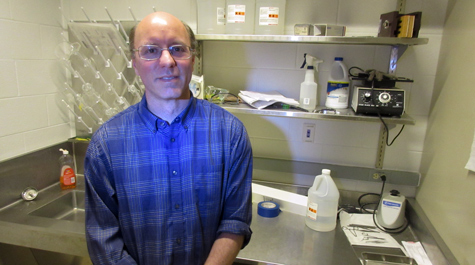Virginia Neuroscience Initiative will expand opportunities for university’s neuroscience program
Participation in the Virginia Neuroscience Initiative will open new opportunities for William & Mary’s neuroscientists.
Josh Burk says the VNI is a component of the Virginia Biosciences Health Research Corporation (VBHRC, also known as “the catalyst”) a state created non-profit corporation. Burk is chair of William & Mary’s Department of Psychology and an affiliated faculty member of the university’s expanding neuroscience program.
“The VNI is an effort to bring together major research institutions within the commonwealth to collaborate more than they have in the past,” Burk explained. “Another aspect is that the commonwealth is putting funds into this, so they’re looking at return on investment.”
Burk said VNI participation would be particularly beneficial for William & Mary’s neuroscience program, an initiative that straddles five departments and conducts one of the university’s most popular undergraduate major programs.
William & Mary is one of seven academic institutions participating as core members of VNI, along with five major medical centers: Carilion Clinic, Inova Health System, Sentara Healthcare, UVA Health System and VCU Health. VNI also includes industrial partners.
Burk says that VNI participation offers a number of benefits, all of which revolve around collaboration. For example, the alliance has increased access to scientific instruments throughout the commonwealth. VNI researchers can use facilities at other VNI institutions at the same rate as researchers in the home institution.
“Say that I had a collaborator at the University of Virginia, I could put a core facility at UVA into my grant proposal,” Burk explained. “It’s something that I would have access to and at the same rate as someone at UVA. It’s going to really strengthen grant proposals.”
He added that VIN’s mission of collaboration matchmaker begins with a registry of Virginia neuroscientists. William & Mary has a couple dozen names on the registry now, and Burk says to goal is to have 50, once the word gets out to students, graduate students and post-docs in the university’s neuroscience community.
“Anyone’s who's interested should be in the registry — students, faculty, graduate students, whomever,” Burk said. “Even if they’re not doing core neuroscience research, they might have expertise that could contribute to neuroscience.”
The registry makes a good starting part to find a collaborator. Burk has been working in a successful long-term, inter-institutional collaboration, a partnership that has received two RO1 grants from the National Institutes of Health. The key to creating a successful research partnership is to find someone who is working on something similar, but who has different, complementary, skills.
“But you need to be compatible to be able to work together,” he said. “This is where the registry helps, because you can call someone up or invite them to come visit.”
Burk pointed out that William & Mary has a lot to offer a statewide neuroscience collaboration, offering a wide range of experts from cellular-molecular research to behavioral and cognitive neuroscience to computational neuroscience.
He added that there are a number of core facilities available on campus as well, led by the nuclear magnetic resonance facility operated by Myriam Cotten, associate professor of applied science.
“That’s a piece of equipment that’s unique within Virginia, and there are very few instruments like that around the world,” Burk said.















